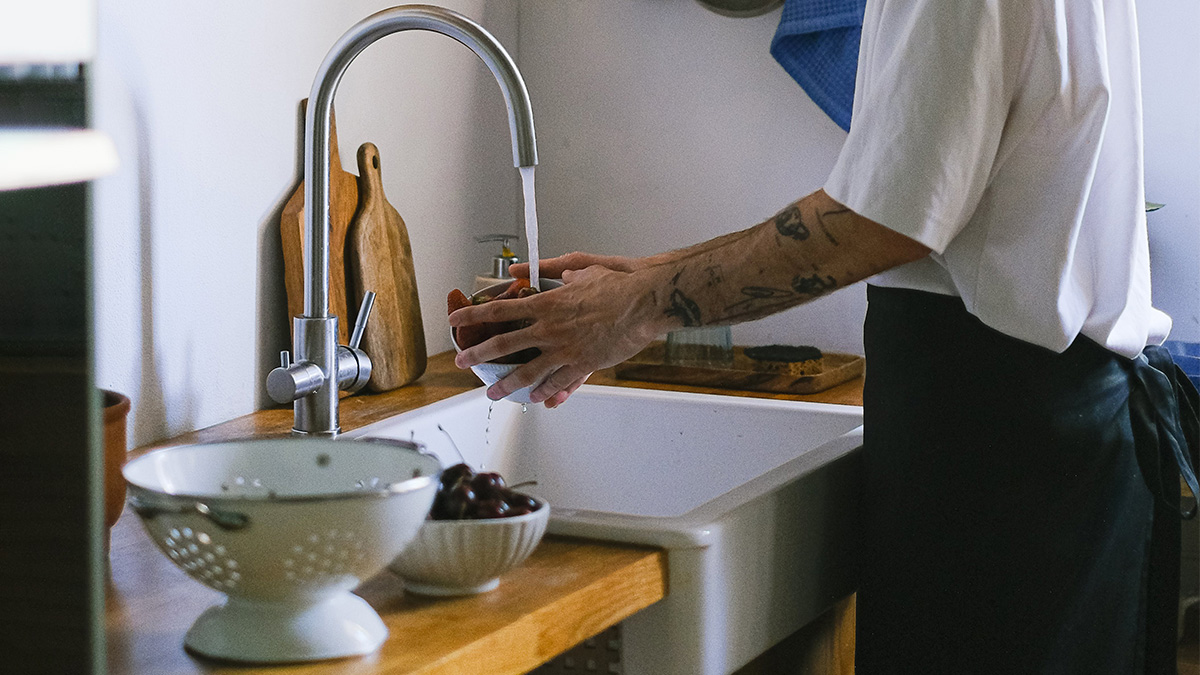I recently sat down with my son to watch an old season of the Teenage Mutant Ninja Turtles. One episode begins with Splinter, the mutant rat sensei and adoptive father of the Ninja Turtles, standing in a meditation posture. He’s just beginning to settle into the practice with a single deep breath when the baby turtles start crawling on him. “It appears that meditation is out of the question for now,” he says.
This scene reminded me that many people have the mistaken idea that meditation is something that only happens under special conditions–in silence and in a particular posture. It’s commonly believed that meditation begins when you set a timer, and if you are able to meet your time, there’s success. If something happens and you don’t, there’s failure. Meditation can even be another thing on the do list, and many people complain that they just didn’t get to it. This reinforces the view that life and practice are separate.
“As I wash dishes, I can also be aware of the comings and goings of thoughts and feelings.”
Yet if we look closely at the Buddhist tradition, we will see multitudes of practices that are skillful means meant to be included in our lives. Practices such as mindfulness and heartfulness can be brought into everything we do, whether or not we set a timer or take a particular posture. When we can expand our view and include more and more of what happens in life, right now, we realize that meditation only appears to start and stop. Without our ideals about what it should be like, each moment becomes a possibility for a more present, loving, and aware life. Of course, this is easier said than done, so it can help to remember the following.
1. Be Willing to Change Your View
It’s not your fault that you may fall into the life and practice split. The gap can feel quite large at times. In fact, the whole of the Buddhist tradition started with this split. This can lead us to feel disempowered in our practice. It can be obvious such as, “If only I could go on one of those meditation retreats,” and it can be as subtle as, “I have no time for practice because my kids keep me so busy.” Both of these statements split meditation and dharma practice into the category “it isn’t here now.”
This leads us to think that we have to wait until the conditions in our life are more suitable for practice. It can be painful to sense this split, yet as my heart teacher, Trudy Goodman, reminds us, “The contents of this moment are the contents for awakening.” When we are dedicated to bringing awareness to our moment-to-moment experience, what is happening in any given moment can be an opportunity to be mindful. If the mind is busy, then we can simply note, “busy mind is like this.” If we can reframe our view to one that is inclusive of our full experience, then it frees us up to be present now. We don’t have to wait for some future moment.
2. Treat Simple Chores as Rituals
Some parts of life are just not enjoyable all the time. Maybe not a lot of the time. Yet, here we are. The laundry needs to be done, our teeth need to be brushed, and the dishes washed. The list can get long and overwhelming. These are also the things that can appear to take us away from being able to practice. But what if we treated them as rituals?
The word ritual comes from the Latin ritus, “to fit together.” These normal acts can weave us together. I invite you to bring to mind all the human beings that you know. Now, imagine them all doing their dishes. Perhaps expand to include all the people in your community. A lot of them are going to be washing dishes today. Simple and ordinary acts can bring us into connection and allow us to practice together. A lot of people are doing them, and in some ways, these simple aspects of life bring us together.
There is a saying in the tradition that “the dharma is good in the beginning, the middle, and the end.” Each one of these tasks also has a beginning, and a middle, and an end. Mindfulness practice invites us to keep some of our attention in our body and yet also expand to include more and more and more of our experience. There is a possibility that, as I wash dishes, I can also be aware of the comings and goings of thoughts and feelings. I’ve had many moments of sadness and joy as the water runs over my hands, as the movement of washing happens. The cycle may begin with resistance and dread, yet there are many times when it ends with a sense of joy, relaxation, and presence. I aim to let in the moments of completion and realize the cycle will begin again. Life really is full of these opportunities to aim for being here fully with the rhythms of things. Dipa Ma, a teacher in the Theravada tradition, put it like this, “When I’m moving, shopping, everything, I’m always doing it with mindfulness. I know these are things I have to do, but they aren’t problems. On the other hand, I don’t spend time gossiping or visiting or doing anything, which I don’t consider necessary in my life.” Perhaps that is the challenge, to consider our lives with care and treat everything in it as a deliberate action.
3. Include Your Relationships
One of the most challenging aspects of practice is the fourth foundation of mindfulness, which is our relationship to what is happening, especially when we’re reactive and there are contracted feelings. It could just be with what is happening in our inner experience, yet as the Satipatthana Sutta, the text that teaches the practice of mindfulness, leads us to realize, in order to really practice, there needs to be an inclusion of both the inner experience, outer experience, and then both together.
Dr. Dan Siegel, who is highly involved in mindfulness and developed the field of Interpersonal Neurobiology, has worked to validate that “The self as experienced as the “mind” is in fact both embodied and relational. These brain-scan findings offer supportive empirical evidence that the mind is, in fact, emerging from both the bodily and the social contexts in which we live.” So, let’s remember to hold all our relationships with ourselves and others as part of our practice. When someone walks into a room in a bad mood, and you react, it isn’t your fault. We are embedded in this life together. In those moments, if we can remember, with mindfulness, it can help break the trance, and we can influence the situation. Learning to foster mind states of happiness, joy, and calm can be of great benefit to this world. We can influence people with our ability to do so, and it can be as simple as noticing our reactivity and being willing to incline to care. I do this over and over again with my kid.
So, next time you are in a crowded room, alone in your car, washing your dishes or, if like me, you have an electric toothbrush that buzzes every thirty sections, remember that this is it. This whole life is here to remember presence with awareness and love. That’s the practice if you’re up for it.

